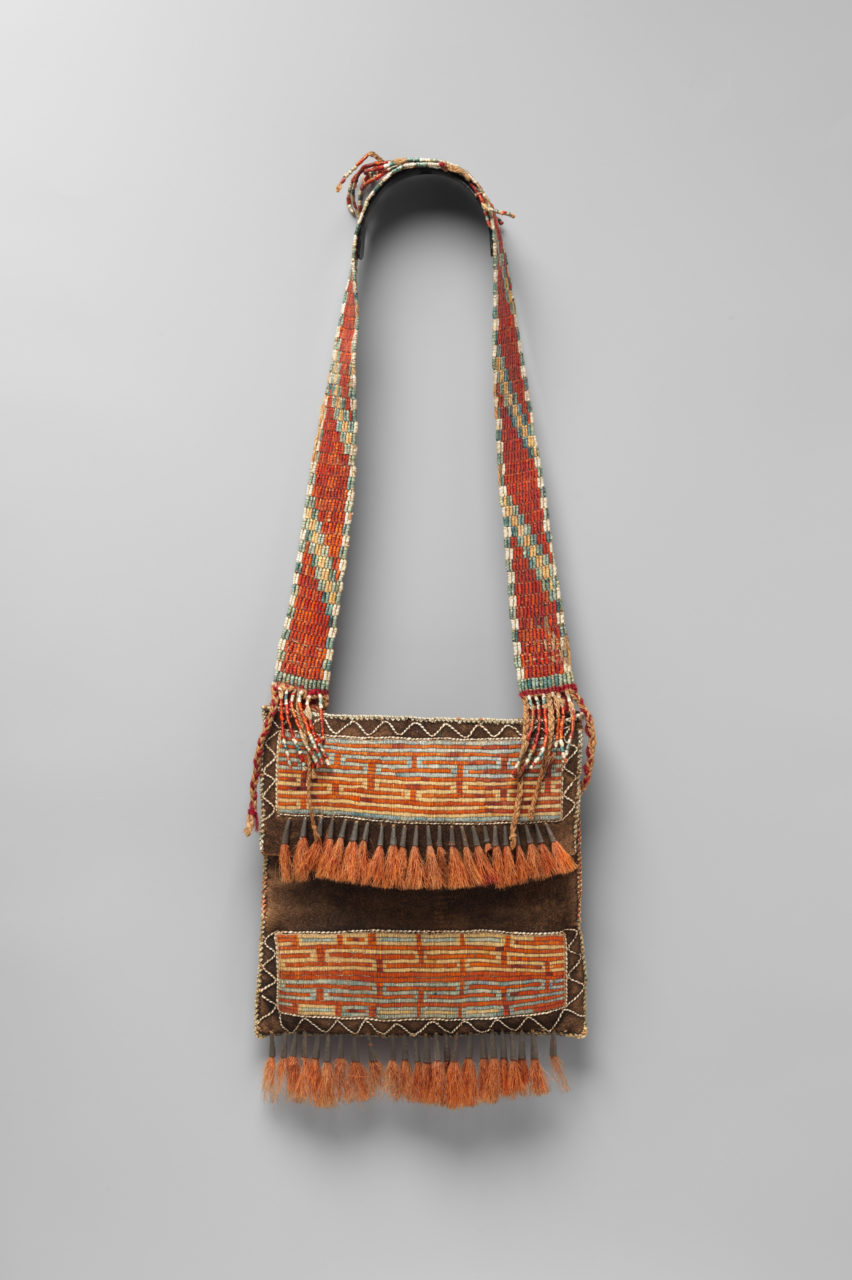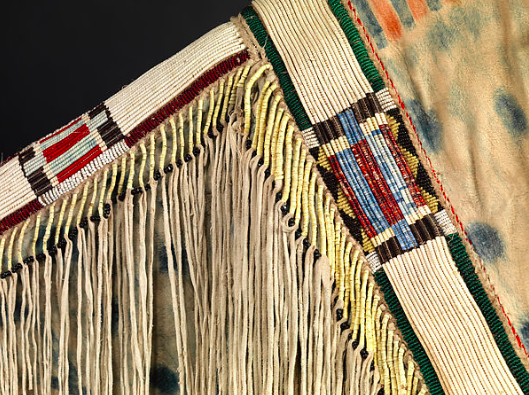Quillwork is a method of textile ornamentation among some North American Indian groups that employs the quills of porcupines, often flattened or dyed, to be used as a decorative embellishment.
The Details
I n A Life in Beads: The Stories a Plains Dress Can Tell (2021), the National Museum of the American Indian describes the process of quillwork, which is an ongoing Plains tradition of clothing decoration and adornment:
“the quills have to be pulled from the hide, washed, dyed, dried, sorted by size, and then softened in the mouth and flattened. Although more difficult and time consuming than beadwork, quillwork is still done by Plains artists today” (7).
In the Northern Plains, porcupines were often found along rivers and streams in great numbers. The sharp and needle-like quills that grow on porcupines were one of the first materials used to decorate and adorn clothing. Once removed from the hide, the porcupine quills were softened, flattened, and wrapped or woven around other material. Porcupine quills varied in length and thickness, and as a result, had to be sorted to find the best quills, which would often come from the sides of the animal (7). These quills were sometimes dyed different colors, using plants, flowers, and berries, in order to make detailed designs. These designs were usually abstract, and took the form of geometric or rounded patterns in a wide variety of colors, as seen on the garment in figure 1. A 19th-century Northern Plains man’s shirt (Fig. 1) depicts the use of brilliant colors and patterns of quillwork used to ornament garments.
Fig. 1 - Maker unknown (probably Northern Plains (attributed); possibly collected from the Lakota (Teton/Western Sioux)). Man's shirt, 1885-1900. Hide, porcupine quills, feather/feathers, horsehair, human hair, silk ribbon, rabbit skin/fur, weasel skin/fur, metal items; 83 x 162 x 5 cm. New York: National Museum of the American Indian, 12/2160. George H. Bingenheimer, Non-Indian, 1861-1920. Source: National Museum of the American Indian
Vincent Thompkins in American Eras (1997) calls decorative quillwork the most unique native North American art form. The technique was prevalent prior to the trade of European manufactured glass trade beads. Woven quillwork was often applied to leather objects such as shirts, moccasins, or bags like the belt pouch pictured in figure 2. This decorative technique utilizes plucked quills from porcupines or birds, which native women would dye, and use to create dense mosaic-like patterns:
“The designs, usually abstract as opposed to figural, often took the form of geometric or curvilinear patterns in a variety of colors, including black, red, yellow, and occasionally blue.” (59)
The bold color palette previously mentioned was characteristic of northeastern Woodlands quillwork of the period, and is depicted on the belt pouch (Fig. 2), which features vivid red, black, and white quills.
The Metropolitan Museum of Art has another example of an accessory featuring quillwork in their collection, which is a shoulder bag from ca. 1780 (Fig. 3). On the shoulder bag, you can see the porcupine quills applied in three distinct ways, demonstrating the artist’s acute attention to design and detail. For the horizontal panels, colorfully dyed quills were carefully loom woven, while the panels along the bottom and top feature naturally white quills that were sewn directly onto the black-dyed leather to create a zigzag motif. Netted quillwork can be seen on the strap, in which dyed quills were wrapped around alternating pairs of leather thongs; this technique disappeared by the early nineteenth century.
Fig. 2 - Maker unknown (Haudenosaunee/ Iroquois (?), Native American). Belt pouch, ca. 1800. Tanned leather, porcupine quills, dye, metal cones, and deer hair; 38.1 x 10.2 cm (15 x 4 in). New York: The Metropolitan Museum of Art, 2019.456.28. The Charles and Valerie Diker Collection of Native American Art, Gift of Charles and Valerie Diker, 2019. Source: The Met
Fig. 3 - Maker unknown (Anishinaabe, probably Ojibwa, Native American). Shoulder bag, ca. 1780. Tanned leather, porcupine quills, dye, metal cones, deer hair, vegetal fiber, and wool yarn; 54.6 × 19.7 cm (21 1/2 × 7 3/4 in). New York: The Metropolitan Museum of Art, 2018.867.4. The Charles and Valerie Diker Collection of Native American Art, Gift of Charles and Valerie Diker, 2018. Source: The Met
In The History of World Costume and Fashion (2011), fashion historian Daniel Delis Hills expresses the importance of decoration like quillwork in symbolizing the preeminence of a family:
“Quillwork likewise represented prosperity in that a group with plenty of food had the leisure time and resources to produce these kinds of lavish decorations for clothing and accessories. Porcupine quills and sometimes stripped bird quills were cut into uniform lengths and dyed colors. These multi-hued quill beads were then appliqued in symbolic and spiritual patterns on almost all outer surfaces of clothing… and especially on accessories like belts and moccasins. Later, manufactured glass and ceramic beads replaced natural quills for the production of decorative appliqués.” (309)
The war shirt pictured in figure 4, along with other ceremonial tunics, were often ornamented with quillwork, feathers, horsehair tassels, and fringe. Men’s tunics, such as war shirts were constructed out of two hides, one was used for the torso and the other was used for the sleeves. The two full-size skins of deer, antelope, bighorn sheep, or small buffalo became a canvas for a female artist to decorate (Hill 307). On these special tunics, multi-colored quills were applied in symbolic and spiritual patterns.
Fig. 4 - Maker unknown (Niimíipuu / Nez Perce, Native American). War shirt, ca. 1850. Tanned leather, pigment, horsehair, porcupine quills, dye, glass beads, and wool cloth; 83.8 × 152.4 cm (33 × 60 in). New York: The Metropolitan Museum of Art, L.2018.35.67. Loan from the Charles and Valerie Diker Collection. Source: The Met
Fig. 4 - Maker unknown (Niimíipuu / Nez Perce, Native American). War shirt detail, ca. 1850. Tanned leather, pigment, horsehair, porcupine quills, dye, glass beads, and wool cloth; 83.8 × 152.4 cm (33 × 60 in). New York: The Metropolitan Museum of Art, L.2018.35.67. Loan from the Charles and Valerie Diker Collection. Source: The Met
Its Afterlife
Indigenous designers like Keri Ataumbi use quillwork as part of their design heritage (Allaire). Through her brand, Ataumbi Metals, the jeweler combines her Kiowa culture’s organic materials, and traditional indigenous elements such as quillwork or featherwork, with innovative and high-tech finishes, computer-aided design, and 3-D printing. The necklaces in figures 5 and 6 are made up of silver, gold, platinum, diamonds, beadwork and quillwork.
Fig. 5 - Keri Ataumbi (Kiowa, 1971-). Elk Necklace with Jamie Okuma, 2019. Silver, gold, platinum, diamonds, beadwork and quill work. Source: Ataumbi Metals
Fig. 6 - Keri Ataumbi (Kiowa, 1971-). Elk Necklace with Jamie Okuma, 2019. Silver, gold, platinum, diamonds, beadwork and quill work. Source: Ataumbi Metals
References:
- Allaire, Christian. “How 6 Indigenous Designers Are Using Fashion to Reclaim Their Culture.” Vogue, https://www.vogue.com/article/indigenous-fashion-designers-cultural-appropriation-activism. Accessed 13 Mar. 2021.
- Hill, Daniel Delis. History of World Costume and Fashion. Upper Saddle River, NJ: Pearson Prentice Hall, 2011. http://www.worldcat.org/oclc/768100950.
- National Museum of The American Indian Education Office. “A Life in Beads: The Stories a Plains Dress Can Tell”. In Native Knowledge 360°. Smithsonian Institution, 2021. Accessed February 03, 2021. https://americanindian.si.edu/sites/1/files/pdf/education/NMAI_lifeinbeads.pdf.
- Tompkins, Vincent. “American Indian Art in the Northeast and Plains.” In Early American Civilizations and Exploration to 1600, 59-61. Vol. 1 of American Eras. Detroit, MI: Gale, 1997. Gale eBooks (accessed February 14, 2021). https://link.gale.com/apps/doc/CX2536600040/GVRL?u=fitsuny&sid=GVRL&xid=20c47623.
















